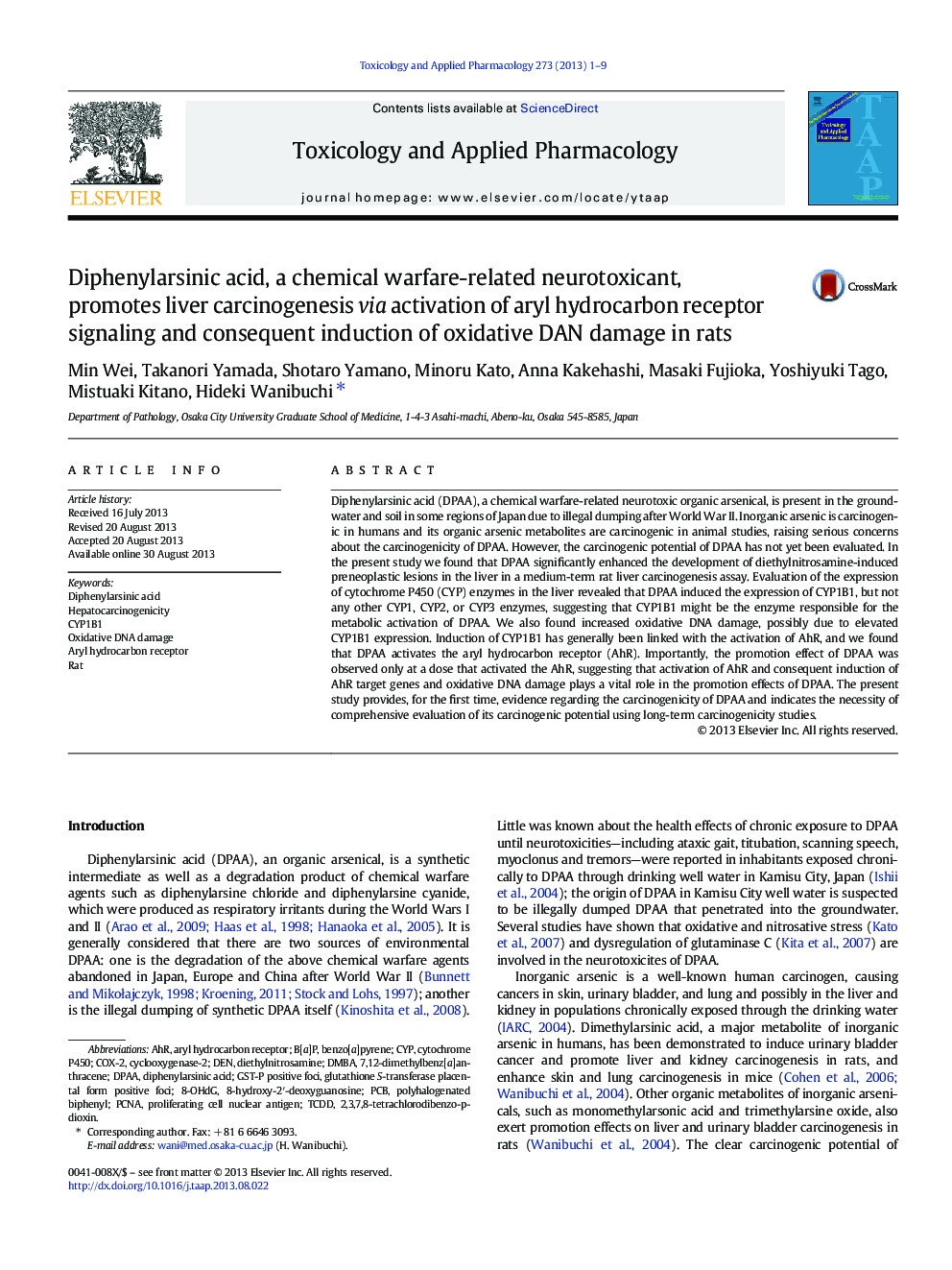| کد مقاله | کد نشریه | سال انتشار | مقاله انگلیسی | نسخه تمام متن |
|---|---|---|---|---|
| 5846517 | 1128488 | 2013 | 9 صفحه PDF | دانلود رایگان |
عنوان انگلیسی مقاله ISI
Diphenylarsinic acid, a chemical warfare-related neurotoxicant, promotes liver carcinogenesis via activation of aryl hydrocarbon receptor signaling and consequent induction of oxidative DAN damage in rats
دانلود مقاله + سفارش ترجمه
دانلود مقاله ISI انگلیسی
رایگان برای ایرانیان
کلمات کلیدی
TCDDPCNAGST-P positive fociDPAAHepatocarcinogenicityCYP1B1Den8-OHdGDMBAAHRPCBCyPCOX-22,3,7,8-Tetrachlorodibenzo-p-dioxin - 2،3،7،8-تترا کلریدیبنزوپتوفان دیوکسین7,12-Dimethylbenz[a]anthracene - 7،12-Dimethylbenz [a] آنتراسن8-hydroxy-2′-deoxyguanosine - 8-هیدروکسی-2'-دگزسی گوانوزینB[a]P - B [a] POxidative DNA damage - آسیب اکسیداتیو DNAProliferating Cell Nuclear Antigen - آنتیژن هسته ای تکثیر سلولیBenzo[a]pyrene - بنزو [a] پییرنdiethylnitrosamine - دیاتیلنیتروستامینDiphenylarsinic acid - دیفنیلارسینیک اسیدCytochrome P450 - سیتوکروم پی۴۵۰Cyclooxygenase-2 - سیکلوکوکسیژناز2Rat - موش صحراییaryl hydrocarbon receptor - گیرنده آرویل هیدروکربن
موضوعات مرتبط
علوم زیستی و بیوفناوری
علوم محیط زیست
بهداشت، سم شناسی و جهش زایی
پیش نمایش صفحه اول مقاله

چکیده انگلیسی
Diphenylarsinic acid (DPAA), a chemical warfare-related neurotoxic organic arsenical, is present in the groundwater and soil in some regions of Japan due to illegal dumping after World War II. Inorganic arsenic is carcinogenic in humans and its organic arsenic metabolites are carcinogenic in animal studies, raising serious concerns about the carcinogenicity of DPAA. However, the carcinogenic potential of DPAA has not yet been evaluated. In the present study we found that DPAA significantly enhanced the development of diethylnitrosamine-induced preneoplastic lesions in the liver in a medium-term rat liver carcinogenesis assay. Evaluation of the expression of cytochrome P450 (CYP) enzymes in the liver revealed that DPAA induced the expression of CYP1B1, but not any other CYP1, CYP2, or CYP3 enzymes, suggesting that CYP1B1 might be the enzyme responsible for the metabolic activation of DPAA. We also found increased oxidative DNA damage, possibly due to elevated CYP1B1 expression. Induction of CYP1B1 has generally been linked with the activation of AhR, and we found that DPAA activates the aryl hydrocarbon receptor (AhR). Importantly, the promotion effect of DPAA was observed only at a dose that activated the AhR, suggesting that activation of AhR and consequent induction of AhR target genes and oxidative DNA damage plays a vital role in the promotion effects of DPAA. The present study provides, for the first time, evidence regarding the carcinogenicity of DPAA and indicates the necessity of comprehensive evaluation of its carcinogenic potential using long-term carcinogenicity studies.
ناشر
Database: Elsevier - ScienceDirect (ساینس دایرکت)
Journal: Toxicology and Applied Pharmacology - Volume 273, Issue 1, 15 November 2013, Pages 1-9
Journal: Toxicology and Applied Pharmacology - Volume 273, Issue 1, 15 November 2013, Pages 1-9
نویسندگان
Min Wei, Takanori Yamada, Shotaro Yamano, Minoru Kato, Anna Kakehashi, Masaki Fujioka, Yoshiyuki Tago, Mistuaki Kitano, Hideki Wanibuchi,